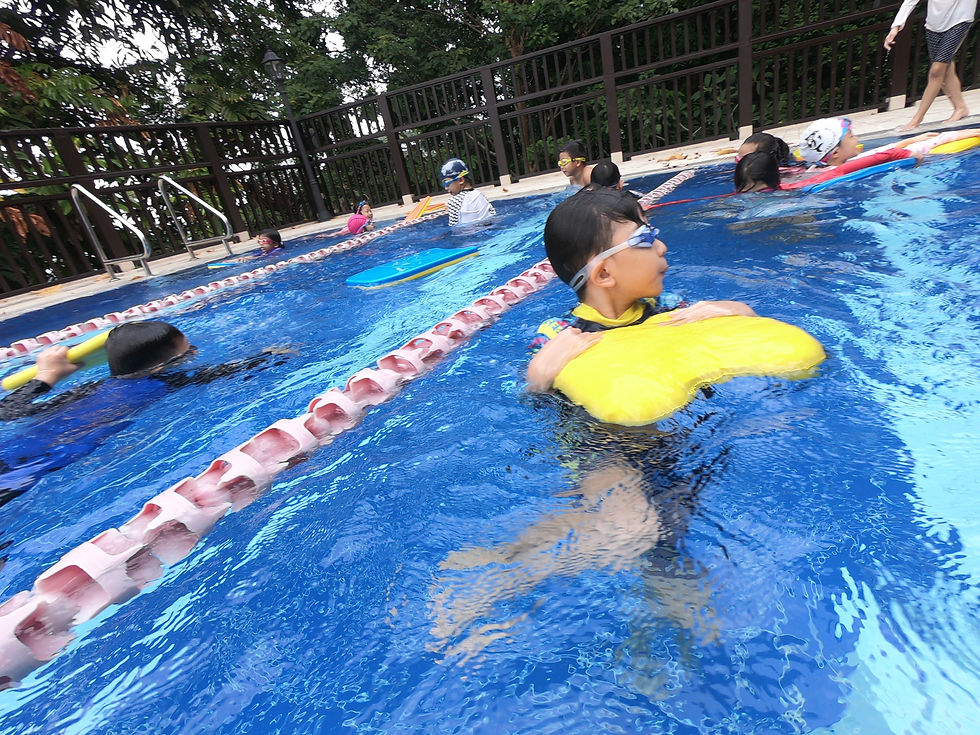How to Avoid Panic During the Triathlon Swim Start
- SG Sink Or Swim

- Apr 11
- 3 min read

The triathlon swim start is often the most intimidating part of race day — even for experienced athletes. With dozens (or hundreds) of competitors launching into the water at once, the combination of tight spaces, cold temperatures, physical contact, and open water anxiety can trigger panic, shallow breathing, or even a DNF (Did Not Finish).
But panic is avoidable. With the right mindset, training, and techniques, you can take control of your nerves and start your race with confidence.
In this article, you’ll learn why panic happens, how to prepare mentally and physically, and what to do in the moment to stay calm during your triathlon swim start.
😰 Why Do Triathletes Panic at the Swim Start?
The chaos of the swim start can overwhelm even strong swimmers. Common triggers include:
Sensory overload (splashing, shouting, and crowding)
Fear of deep or murky water
Unexpected contact with other swimmers
Hyperventilation from cold water or anxiety
Poor visibility and lack of orientation
Recognizing these factors is the first step in managing them effectively.
🧠 1. Train Your Mind as Much as Your Body
✔️ Visualize Calm Success
Before race day, spend a few minutes daily visualizing a smooth, confident start — lining up, entering the water, settling into your rhythm.
✔️ Practice Controlled Breathing
Train yourself to breathe slowly and deeply, even when nervous. Inhale for 4 counts, exhale for 6. This activates your parasympathetic nervous system, calming your body.
✔️ Embrace the Discomfort
Acknowledge that the swim start won’t be perfectly comfortable — and that’s okay. You’re trained. You can handle it.
🏊♂️ 2. Simulate Race Conditions in Practice
✔️ Group Swim Practice
Train with a group in open water or pool lanes. Practice starts shoulder to shoulder with others to get used to contact and crowded conditions.
✔️ Start with Sprint Surges
During swim sets, do 25–50m fast starts to simulate race effort, followed by slower, controlled swimming. This conditions your body to manage the spike in effort.
✔️ Practice Sighting & Breathing
Regularly lift your head to sight a target, just like in open water. Combine this with bilateral breathing to stay centered and aware of your surroundings.
❄️ 3. Acclimate to Cold Water
Cold water can trigger the gasp reflex, rapid heart rate, and panic. Ease into it before race day:
Take cold showers in the weeks before your race
Do open water practice swims in wetsuits
On race morning, splash cold water on your face and neck to prepare your body
If allowed, warm up in the water before your wave start
📍 4. Position Yourself Strategically at the Start
You don’t need to line up with the front pack unless you’re an elite swimmer.
✔️ Choose Your Spot Wisely:
If you’re nervous, start at the side or back of your wave
Pick the outer edge of the pack to avoid being swamped in the middle
Let aggressive swimmers go ahead — you’ll find clean water and a steady pace
🌊 5. Control Your First 100 Meters
The first minute sets the tone for your entire swim. Go out too hard, and panic might strike. Instead:
Start slower than you think you should
Focus on long exhalations underwater
Count your strokes or repeat a calming mantra (“breathe and glide”)
Let your stroke tempo build naturally as your heart rate stabilizes
✅ Tip: Practice a 3-5-3 breathing pattern (3 strokes, breath, 5 strokes, breath) to regulate your breathing rhythm early.
🆘 6. Know What to Do If Panic Strikes
Even with preparation, panic can happen. What matters most is how you respond.
Stay Calm and:
Roll onto your back to float and breathe
Tread water or do a breaststroke kick to calm down
Focus on exhaling fully underwater
Sight a nearby kayak or buoy for orientation
💡 Remember: Most races have support kayaks and lifeguards nearby. You’re not alone.
🧩 7. Build a Pre-Race Routine That Centers You
Create a personal warm-up ritual to reduce stress before entering the water:
Light dynamic stretches and mobility drills
Short jog or arm swings to elevate heart rate
Controlled breathing and visualization
A familiar mantra or music to calm your nerves
This signals your body that you are in control and ready.
✅ Final Thoughts: Confidence Is Trainable
Panic at the triathlon swim start isn’t about fitness — it’s about how your brain reacts to a stressful environment. But just like endurance and technique, confidence can be trained.
By preparing mentally, simulating race conditions, controlling your breathing, and having a plan for race day, you can take the fear out of the swim and replace it with focus, control, and confidence.





Comments